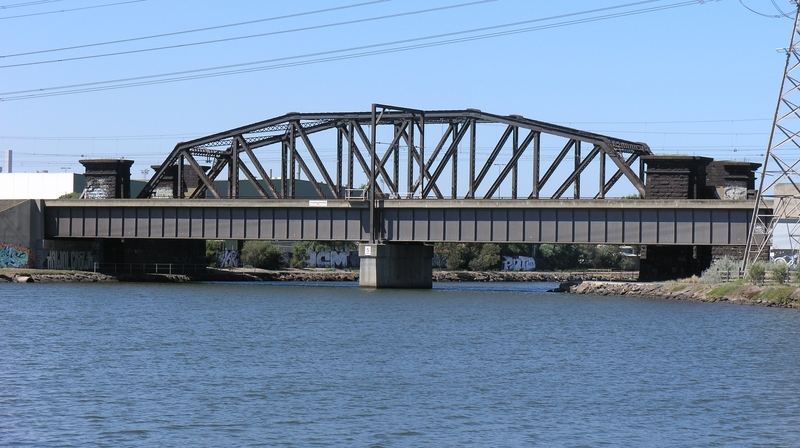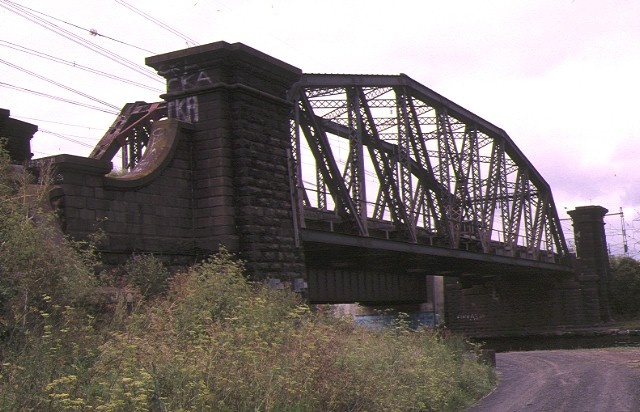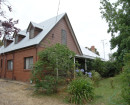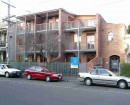RAIL BRIDGE
OVER MARIBYRNONG RIVER, FOOTSCRAY AND WEST MELBOURNE, MARIBYRNONG CITY, MELBOURNE CITY
-
Add to tour
You must log in to do that.
-
Share
-
Shortlist place
You must log in to do that.
- Download report



Statement of Significance
What is Significant?
The double track railway bridge was proposed by the Melbourne Mt Alexander & Murray River Railway Company, to carry its Melbourne-Williamstown line across what was then the Salt Water River. The government acquired the company's faltering operations in 1856, and the design and erection of the bridge became the responsibility of George C Darbyshire, the first Engineer in Chief, of the newly formed Victorian Railways Department. The massive tubular box girder iron bridge with bluestone abutments was erected in 1858-59. The iron girders were fabricated in Manchester by William Fairbairn & Sons. It has been claimed that the eminent English engineer Isambard Kingdom Brunel, who arranged manufacture of the girders and acted as Inspecting Engineer, made minor modifications to the design to save costs and to simplify and facilitate fabrication. The girders, which spanned 200 feet (60.9 metres), were erected by George Holmes & Company on bluestone abutments constructed by Pierce & Dalziel. In 1911 Mephan Ferguson, a local engineering firm, contracted to replace the box girder span with the present through hog-back Pratt steel truss structure in order to accommodate heavier loads.
How is it significant?
The railway bridge over the Maribyrnong River is of historic and scientific importance to the State of Victoria.
Why is it significant?
The bridge is historically important as a significant remnant of the primal development phase of railways in Victoria. Although built by the Victorian Railways, the bridge was a significant part of the infrastructure proposed by the Melbourne, Mt Alexander & Murray River Railway Company, one of a small number of private companies which constructed railways in Victoria during the 1850s and 1860, before the government assumed this responsibility.
The bridge is scientifically important because the iron structure of the original bridge, of which the bluestone abutments are now the only extant part, and the steel structure of the present span were unusual types of construction. At the time of their erection the original and present span structures were the largest of their type in Victoria, if not Australia. The bridge is a significant work of George Christian Darbyshire, the first Engineer in Chief of the Victorian Railways (1856-60). The existing steel structure, which replaced the original box girders, is an important work of Mephan Ferguson, an eminent local ironfounder, railway contractor and wrought iron pipe manufacturer.
-
-
RAIL BRIDGE - History
Contextual History:History of Place:
Following the gold rushes of the early 1850s the Victorian government, realising that railways would be required to replace the existing primitive horse drawn road transport services, offered inducements to syndicates proposing to construct railways. Early in 1853 the Legislative Council approved the incorporation of three railway companies. The Melbourne & Hobson’s Bay Railway Company moved quickly, and by September 1854 had opened its line from Flinders Street to Sandridge (Port Melbourne). This was the first steam operated railway in Australia.
The Geelong and Melbourne Railway Company began construction of its line at Geelong in September 1853 and ran its first train, as far as Greenwich (now Newport), in June 1857. Its Melbourne terminus was originally planned to be at Williamstown, but in 1854 the company arranged with the newly formed Melbourne, Mt Alexander & Murray River Railway Company, for running rights over the branch line it proposed constructing between Melbourne and Williamstown.
The Melbourne, Mt Alexander & Murray River Railway Company was formed in 1853 to construct a line from Melbourne to the New South Wales border via the gold mining areas of Castlemaine and Bendigo, and also a branch line between Melbourne and Williamstown. The company received a grant of land on Batman’s Hill, fronting Spencer Street, for its Melbourne terminus.
The Melbourne, Mt Alexander & Murray River Railway Co. found difficulty in organising finance for its lengthy country line, and little was initially done. Eventually the company decided to begin construction of the branch line between Melbourne and Williamstown, and an official inauguration ceremony took place at Williamstown on 12 June 1854. Construction of the line was to begin at both ends but inadequate funds hindered progress and little more than local works on a limited scale were carried out. In March 1856 the government decided to purchase the faltering project and immediately complete the Melbourne-Williamstown line, in order to form a focus for country lines the government was planning to construct. At the same time the government created the Victorian Railways Department under the Commissioner of Public Works.
Under the terms of purchase the Commissioner of Public Works and the Surveyor General were appointed trustees of the railway company. During the following month the new railway department called tenders for the Melbourne-Williamstown line. This line required two major engineering structures - a large bridge over the Maribyrnong (Salt Water) River and a railway pier (Breakwater Pier) at Williamstown.
In November 1857 the Government approved the construction of a railway from Melbourne to the Murray River and from Geelong to Ballarat as it believed that all main railways should be government controlled. The Footscray-Sunbury section of the former line was completed by December 1858 and it was decided that the opening of this line should be synchronised with that of the completed Melbourne-Williamstown line. Both lines were officially opened on 13 January 1859. This was the first Government built line in Victoria.
HISTORY OF PLACE
George Christian Darbyshire was appointed the first Engineer in Chief of the Victorian Railways Department in 1856, and remained in that post until he resigned in 1860 following criticism from the Commissioner of Public Works. (Darbyshire again occupied this position in 1891). Darbyshire had entered the Government service in August 1853 in the Surveyor-General’s Department, and at the time of his appointment as Engineer in Chief, was District Surveyor at Williamstown. In November 1856 Darbyshire reported to the Trustees of the Melbourne, Mt Alexander and Murray River Railway on the progress of the construction of the Melbourne-Williamstown line. He reported that drawings and specifications for the wrought iron bridge over the Salt Water River had been sent to England on 25 June 1856, followed by duplicate correspondence the following month. He also mentioned that drawings and specifications for the masonry work were well advanced, and that the foundations would be costly because the banks of the river were composed of soft mud to a great depth.
The specification for the wrought iron tubular girder bridge called for it to have:
...one span of two hundred feet in the clear between the piers, and to consist of three wrought iron tubular girders, each of two hundred feet clear span, supported upon two stone piers twenty-one feet six inches above high water level. Each girder is to have eight feet bearing each end upon the piers, making the total length of each girder two hundred and sixteen feet. The girders are to be placed parallel to each other, and fifteen feet nine inches apart. The roadway is to be carried upon longitudinal sleepers resting upon, and bolted to the angle-irons of the cross bearers. The cross bearers are to be of wrought iron, in one length, reaching from outside to outside girder, and riveted to the bottoms of the outside girders, and riveted and bolted also to the centre girder.
The girders were to have a depth of fourteen feet three inches and an eighteen inch high moulded iron coping along the top. Nearly 600 tons of iron was to be used in the fabrication.
In October 1856 Captain Douglas Galton RE was appointed Inspecting Engineer to supervise contracts for supply of materials in England. Two months later Galton was replaced by the eminent engineer Isambard Kingdom Brunel, whose first task was the opening of the tenders called by his predecessor. Twelve tenders were received for fabrication of the bridge ironwork. William Fairbairn & Sons of Manchester was awarded the contract with a tender of twelve thousand five hundred and sixty eight pounds.
Brunel immediately reported to Darbyshire and advised of changes he had made to improve the design and to simplify and facilitate fabrication. Brunel dispensed with the side rollers and the cross ties or arches at the ends of the bridge. He also omitted the ornamental coping to the girders on the grounds that
...the manufacturer wanted a large price for it; if cast iron it would have been liable to be broken on the voyage, and in wrought it would have been costly; it can be more easily added in wood if you think the appearance requires it.
In closing his report to Darbyshire Brunel offered some advice from his vast experience of bridge building. He said that having regard to economy of first cost, facility of construction and repair, he preferred having two distinct bridges, one for each set of rails, to a bridge comprised of three girders, and that he would “never use a bridge with double roadway, unless close to a station, where it is possible a crossing or an oblique line of rails may be required on the bridge”. Brunel also advised that the clear width of bridges should be limited to 12 or 13 feet.
Darbyshire gratefully acknowledged the suggestions and said that
...fortified by your authority, I may, hereafter when designing similar descriptions of bridges venture to reduce the weight of the material to an extent which I should not otherwise have felt justified in doing. May I, however, venture to draw your attention to the fact that a gentleman of your eminence could readily venture upon constructing a bridge or any other work without risking loss of reputation in case of failure. And hence arose the necessity of my making those bridges of a strength sufficient to stand a test which, in your case, would be deemed quite unnecessary.
He said that he had written the specification in a way which gave the Inspecting Engineer wide discretionary powers. He also defended his choice of a three girder bridge on the grounds that although the method was more expensive, it had the advantage that one half of the bridge could be completed and used as early as possible.
The abutments and foundations for the bridge were constructed by Pierce and Dalziell, at a cost of 31,737 pounds. Foundations for the bridge required 600 piles driven to a depth of 60 feet. George Holmes & Co erected the steelwork for 30,331 pounds. This company also erected a smaller bridge which carried the line over Stony Creek. The cost of the Maribyrnong River bridge amounted to 90,000 pounds and the total cost for the completed line at the time of opening was 697,000 pounds.
The bridge was completed in December 1858 and tested on 7 January 1859, just six days before the official opening of the line. Two engines, each hauling six wagons loaded with iron rail chairs were used for the load test. On the opening day, , the bridge was decorated with flags and an arch of greenery and the official train passed across it at 25 miles per hour.
Thirty years after its construction the bridge still had the largest span of any bridge in Victoria, and it was believed that it had the second greatest span of any railway bridge in Australia.
After the turn of the century the Victorian Railways began using heavier locomotives which could draw greater loads. Consequently many bridges throughout the state had to be strengthened to take the increased stresses. In 1905 timber piles were driven under the Maribyrnong River bridge and timber crossheads were provided to temporarily support the overstressed bridge until a new bridge could be constructed.
Following unprecedented flooding of the river in September 1906 legal actions were to be taken against the Victorian Railways arising out of damage claims caused by the temporary piles interrupting the river flow. Although a scheme to alleviate future flooding by construction of a longer bridge to the west was proposed this did not eventuate. Instead, instructions were issued on 31 July 1911 to reconstruct the superstructure of the bridge at an estimated cost of 16,000 pounds. In October 1911 Mephan Ferguson contracted to replace the three girders of the Salt Water River bridge with two mild steel through hog-back Pratt trusses at a cost of 11,281 pounds.
Mephan Ferguson set up his engineering business in Melbourne during the mid 1870s and carried out many government contracts. One of his early contracts was for the manufacture of the ironwork and erection of the Johnston Street bridge in Melbourne. He erected twenty bridges on the North-Eastern railway and eight on the Clifton Hill line. In addition to constructing many railway footbridges, road bridges, gas holders and the ironwork for the extensive Newport railway workshops, Ferguson also established a successful wrought iron pipe manufacturing business and during the late 1880s established a large factory in Footscray.
To modify the bridge superstructure the bridge deck was independently supported on timber props and an overhead timber structure was constructed off the two outside girders along the length of the bridge. A travelling gantry crane which operated along the overhead structure enabled construction of the two steel trusses from above. Each truss is 11.8 metres high and weighs 190 tonnes. As the spacing of the new trusses was less than that of the outer girders of the original bridge the new structure was built within the outer girders. On completion of the trusses the girders were cut up and removed. The whole of the work was done without disruption of rail services. The whole project was completed on 31 October 1914
In 1976 a new two-span steel plate girder bridge was constructed adjacent to and upstream of the original bridge to carry the tracks of the St Albans line.RAIL BRIDGE - Permit Exemptions
General Exemptions:General exemptions apply to all places and objects included in the Victorian Heritage Register (VHR). General exemptions have been designed to allow everyday activities, maintenance and changes to your property, which don’t harm its cultural heritage significance, to proceed without the need to obtain approvals under the Heritage Act 2017.Places of worship: In some circumstances, you can alter a place of worship to accommodate religious practices without a permit, but you must notify the Executive Director of Heritage Victoria before you start the works or activities at least 20 business days before the works or activities are to commence.Subdivision/consolidation: Permit exemptions exist for some subdivisions and consolidations. If the subdivision or consolidation is in accordance with a planning permit granted under Part 4 of the Planning and Environment Act 1987 and the application for the planning permit was referred to the Executive Director of Heritage Victoria as a determining referral authority, a permit is not required.Specific exemptions may also apply to your registered place or object. If applicable, these are listed below. Specific exemptions are tailored to the conservation and management needs of an individual registered place or object and set out works and activities that are exempt from the requirements of a permit. Specific exemptions prevail if they conflict with general exemptions. Find out more about heritage permit exemptions here.Specific Exemptions:EXEMPTIONS FROM PERMITS:
1. All works to the deck of the bridge involving track and ballast repair or
replacement.
2. Repair, replacement or renewals of all wires and cables required for
operational and safety purposes relating to the daily use of the bridge.
3. Any emergency works relating to the substructure and the superstructure of
the bridge.
-
-
-
-
-
TERRACE
 Victorian Heritage Register H0077
Victorian Heritage Register H0077 -
HENDERSON HOUSE
 Victorian Heritage Register H0183
Victorian Heritage Register H0183 -
SALTWATER RIVER CROSSING SITE AND FOOTSCRAY WHARVES PRECINCT
 Victorian Heritage Register H1397
Victorian Heritage Register H1397
-
'Altona' Homestead (Formerly 'Laverton' Homestead) and Logan Reserve
 Hobsons Bay City
Hobsons Bay City
-
-












